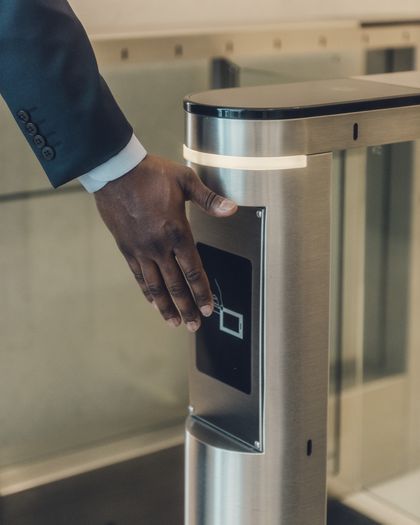It’s becoming the “fourth utility” in commercial real estate.

As tenants continue their migration back into the workplace, they are discovering the integration of access control and touchless technology systems in parking garages, restrooms, kitchen areas and other common spaces to reduce physical contact and the spread of germs. A recent webinar hosted by Realcomm explored how landlord practices, including touchless technologies, are improving the physical security, health and safety of employees, as well as their mindset.
Kasara Smith, Director at Cushman & Wakefield, provided a case history on the installation of hands-free technology at The McPherson Building, a 12-story asset in Washington, D.C. approximately two miles north of The White House.
“We started the upgrades pre-COVID in 2018 but the timing could not have been better in our goal to move away from key fobs and access cards that are typically unwieldy and often lost,” Smith explained.
Touchless controls were installed in the elevators, tenant suites and fire and life safety systems in an effort to make the building “future-proof.” One unintended improvement was tenant access to the garage entrance, which featured an extremely tight right-hand turn that required drivers to perform gymnastics to flash their access card and activate the doors. “Now, as the car approaches, the rolling doors open instantaneously,” Smith said.
Mark Evans, Brandywine Realty’s Senior Director of Digital Engineering, has overseen the installation of access control readers and applications activated by near-field communication (NFC) and Bluetooth systems from smartphone devices. The systems have been implemented at delivery stations for UPS, FedEx and Amazon, package lockers and parking kiosks. They can also activate sanitation and cleaning sensors and provide remote access for engineers and contractors to building systems.
But Evans cautions, “High tech doesn’t always offer the best solution, as a simple door prop can often be better and more reliable than a complicated access system.”
John Dulin, VP of Market Development for Corning, calls wireless and touchless technology the “fourth utility” that is now on equal footing with electricity, HVAC and water systems, and should incorporate infrastructure that can last the life of the building.
“None of us are strangers to the role of technology as we carry multiple devices, but installing touchless technology to combat COVID-19 represents the new reality of staying safe and getting back to work,” Dulin said.
April Bertram, Senior Business Development Director for GOJO Industries, presented research that provided a glimpse into the mindset of employees regarding workplace cleaning and hygiene. Among her findings:
- 94% of all employees are washing or sanitizing their hands more frequently;
- observing cleaners in restrooms during the daytime is a top indicator of cleanliness;
- 9 out of 10 people want touchless systems in restrooms;
- 8 of 10 say the condition of the restroom reflects how much an employer cares about the company’s image;
- paper towels are preferred over air dryers by two-thirds of the respondents; and
- 8 out of 10 consumers expect to see hand sanitizers in every corner of the building.
Bertram further explained that employees and tenants are interested in real-time notifications of restroom conditions and a needs-based housekeeping schedule so staff can focus on hot spots.
“Seeing the effort and the equipment is important, including touchless smart hygiene dispensers, will mitigate return-to-office concerns,” she added.